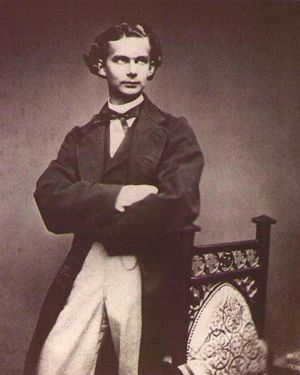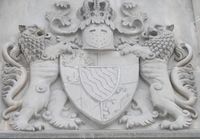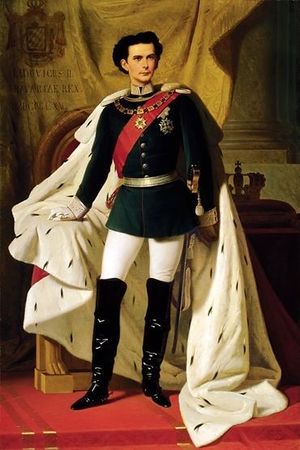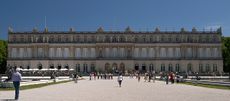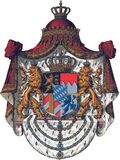لودڤيگ الثاني من باڤاريا
| لودڤيگ الثاني | |||||
|---|---|---|---|---|---|
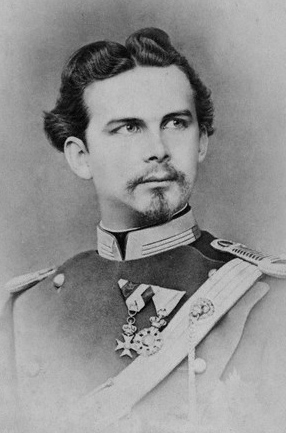 Ludwig in c. 1874 | |||||
| ملك باڤاريا | |||||
| العهد | 10 March 1864 – 13 June 1886 | ||||
| سبقه | ماكسميليان الثاني | ||||
| تبعه | اوتو | ||||
| وُلِد | 25 أغسطس 1845 Nymphenburg Palace, Munich, Bavaria | ||||
| توفي | 13 يونيو 1886 (aged 40) Lake Starnberg, Bavaria, الامبراطورية الألمانية | ||||
| الدفن | |||||
| |||||
| البيت | بيت ڤيتلسباخ | ||||
| الأب | ماكسميليان الثاني من باڤاريا | ||||
| الأم | Marie of Prussia | ||||
| الديانة | Roman Catholicism | ||||
لودڤيگ الثاني Ludwig II أو لودڤيگ اوتو فريدرش ڤلهلم Ludwig Otto Friedrich Wilhelm، (25 أغسطس 1845 - 13 يونيو 1886)[1] was King of Bavaria from 1864 until his death. He is sometimes called the Swan King (الإنگليزية) and der Märchenkönig, the Fairy Tale King (German). He also held the titles of Count Palatine of the Rhine, Duke of Bavaria, Duke of Franconia, and Duke in Swabia.[2]
He succeeded to the throne aged only 18. Two years later Bavaria was effectively subjugated by Prussia, and subsequently absorbed into the German Empire. Ludwig remained King of Bavaria, but largely ignored such state affairs as remained to Bavaria in favor of extravagant artistic and architectural projects. He commissioned the construction of two lavish palaces and the fantastic Neuschwanstein Castle, and was a devoted patron of the composer Richard Wagner.
Ludwig spent all the royal revenues (though not state funds) on these projects, borrowed extensively, and defied all attempts by his ministers to restrain him. This was used against him to declare him insane, an accusation which has since been refuted.[3]
Ludwig is generally well-regarded and even revered by many Bavarians today. His legacy of architecture and art includes many of Bavaria's important tourist attractions.
حياته
سنوات الطفولة والمراهقة
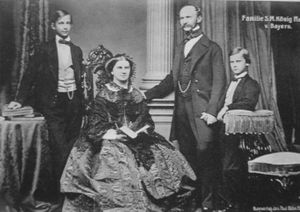
Born in Nymphenburg Palace (today located in suburban Munich), he was the elder son of Maximilian II of Bavaria (then Bavarian Crown Prince) of the House of Wittelsbach, and his wife Princess Marie of Prussia. His parents intended to name him Otto, but his grandfather, Ludwig I of Bavaria, insisted that his grandson was named after him, since their common birthday, 25 August, is the feast day of Saint Louis IX of France, patron saint of Bavaria. His younger brother, born three years later, was named Otto.
بداية حكمه
الحرب الپروسية النمساوية والحرب الپروسية الفرنسية
العلاقات مع پروسيا took center stage from 1866. In the Austro-Prussian War, which began in July, Ludwig supported Austria against Prussia.[4] Austria and Bavaria were defeated; and Bavaria was forced to sign a mutual defense treaty with Prussia which effectively left Bavaria under Prussian control.
When the الحرب الپروسية الفرنسية broke out in 1870, Bavaria was required to fight alongside Prussia. After the Prussian victory over France, Bismarck moved to complete the Unification of Germany. In November 1870, Bavaria joined the North German Confederation. In December 1870, Bismarck by certain financial concessions induced Ludwig to write the so-called Kaiserbrief, a letter endorsing the creation of the German Empire. The Empire was established a few days later, and its crown was awarded to Ludwig's uncle, الملك ڤلهلم الأول من پروسيا.
Bavaria thus lost its status as an independent kingdom, and became a state in the Empire. Ludwig protested this alteration by refusing to attend Wilhelm's 10 January coronation in the Palace of Versailles.[5] Ludwig's brother Prince Otto and his uncle Luitpold went instead.[6][7] Otto criticized the celebration as ostentatious and heartless in a letter to his brother.
However, the Bavarian delegation under Prime Minister Count Otto von Bray-Steinburg secured privileged status for Bavaria within the Empire (Reservatrechte). Bavaria retained its own diplomatic corps and its own army, which would come under Prussian command only in times of war.
الخطوبة والميول الجنسية
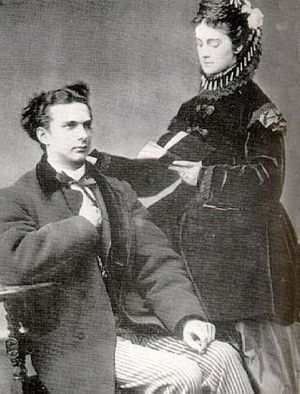
لودڤيگ راعي الفنون
After 1871, Ludwig largely withdrew from politics, and devoted himself to his personal creative projects, most famously his castles, where he personally approved every detail of the architecture, decoration, and furnishing.
لودڤيگ وڤاگنر
Ludwig was intensely interested in the operas of Richard Wagner. This interest began when Ludwig first saw Lohengrin at the impressionable age of 15½, followed by Tannhäuser ten months later. Wagner's operas appealed to the king's fantasy-filled imagination.
Ludwig considered abdicating to follow Wagner, but Wagner persuaded him to stay.
Ludwig provided a residence for Wagner in Switzerland. Wagner completed Die Meistersinger there; it was premiered in Munich in 1868. When Wagner returned to his "Ring Cycle", Ludwig demanded "special previews" of the first two works (Das Rheingold and Die Walküre) at Munich in 1869 and 1870.[8]
Wagner however was now planning his great personal opera house at Bayreuth. Ludwig initially refused to support this grandiose project. But when Wagner exhausted all other sources, he appealed to Ludwig, who gave him 100,000 thalers to complete the work. Ludwig attended the dress rehearsal and third public performance of the complete Ring Cycle in 1876.
لودڤيگ والمسرح
Ludwig's interest in theater was by no means confined to Wagner. In 1867, he appointed Karl von Perfall as Director of his new court theater. Ludwig wished to introduce Munich theater-goers to the best of European drama. Perfall, under Ludwig's supervision, introduced them to Shakespeare, Calderón, Mozart, Gluck, Ibsen, Weber, and many others. He also raised the standard of interpretation of Schiller, Molière, and Corneille.[9]
قلاع لودڤيگ
ميتة غامضة
The next day, 13 June 1886, at around 6 PM, Ludwig asked Gudden to accompany him on a walk through the Schloß Berg parkland along the shore of Lake Starnberg. Gudden agreed; the walk may even have been his suggestion, and he told the aides not to accompany them. His words were ambiguous (Es darf kein Pfleger mitgehen, "No attendant may come along") and whether they were meant to follow at a discreet distance is not clear. The two men were last seen at about 6:30 PM.; they were due back at 8 PM but never returned. After searches were made for more than two hours by the entire castle staff in a gale with heavy rain, at 10:30 PM that night, the bodies of both the King and von Gudden were found, head and shoulders above the shallow water near the shore. The King's watch had stopped at 6:54. Gendarmes patrolling the park had heard and seen nothing.
ذكراه
المباني
- Winter Garden, Residenz Palace, Munich, an elaborate winter garden built on the roof of the Residenz Palace in Munich.
- Neuschwanstein Castle,[10] or "New Swan Stone Castle", a dramatic Romanesque fortress with Byzantine, Romanesque and Gothic interiors, which was built high above his father's castle: Hohenschwangau.
- Linderhof Castle, an ornate palace in neo-French Rococo style, with handsome formal gardens. Just north of the palace, at the foot of the Hennenkopf, the park contains a Venus grotto where Ludwig was rowed in a shell-like boat on an underground lake lit with red, green or "Capri" blue effects by electricity, a novelty at that time, provided by one of the first generating plants in Bavaria.[11] Stories of private musical performances here are probably apochryphal; nothing is known for certain.[12]
- Herrenchiemsee, a replica (although only the central section was ever built) of Louis XIV of France's Palace of Versailles, France, which was meant to outdo its predecessor in scale and opulence - for instance, at 98 meters the Hall of Mirrors and its adjoining Halls of War and Peace is slightly longer than the original.
لودڤيگ والفنون
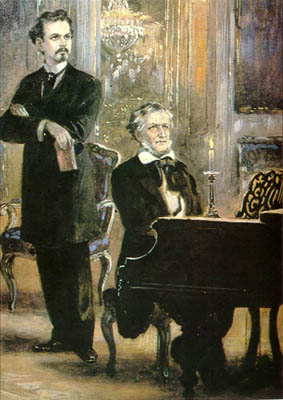
في الثقافة الشعبية
أفلام
- Ludwig II (1922), a silent Austrian film directed by Otto Kreisler and starring Olaf Fjord as Ludwig
- Ludwig II, King of Bavaria (1929), a late German silent film directed by and starring William Dieterle
- Ludwig II: Glanz und Ende eines Königs (1955), a West German film directed by Helmut Käutner and starring O. W. Fischer as Ludwig and Ruth Leuwerik as Empress Elizabeth
- Ludwig (1972), a film directed by Luchino Visconti which traces the life of Ludwig II from his accession to death, and stars Helmut Berger as Ludwig II and Romy Schneider as the Austrian Empress Elisabeth.
- The 1972 German film Ludwig - Requiem für einen jungfräulichen König (Ludwig - Requiem for a Virgin King), written and directed by Hans-Jürgen Syberberg provides a more personal, sympathetic, and idiosyncratic account of the King's life from boyhood to death, and stars Harry Baer and Balthasar Thomass as Ludwig II, and Gerhard Maerz as Richard Wagner.
- An epic film, Wagner (1983), directed by Tony Palmer, on the life of Richard Wagner, starring Richard Burton in the title role, also features László Gálffi in the substantial role of King Ludwig.
- In the 1993 film Ludwig 1881, Helmut Berger reprises his role as Ludwig II in an episode involving the actor Josef Kainz, who is invited to accompany the king on a cruise on a Swiss lake, in order to recreate scenes from a story that actually took place around the lake.
- Ludwig II (2012 film) (2012), directed by Peter Sehr and Marie Noelle, and starring Sabin Tambrea as the younger Ludwig and Sebastian Schipper as the king in his later years.
أدب
- The three-volume manga series Ludwig II (ルートヴィヒII世) by the artist You Higuri, published by Kadokawa Shoten, is a highly fictionalized account of Ludwig's love life.
- Sharyn McCrumb's 1984 mystery novel Sick of Shadows features a character who identifies with Ludwig II and builds a replica of Neuschwanstein castle in Georgia. The novel also acts out a few more disturbing incidents from Ludwig's life.
- The story of Ludwig II is discussed by the characters of the 1947 novel Doktor Faustus by Thomas Mann, in chapter XL.
- Ludwig is the central character in the novel Remember Me (1957) by the American David Stacton (1923-1968).[13] The novel, part of a triptych dealing with "The Invincible Questions"[14] concentrates on Ludwig's psychology, including his notion of kingship, his homoerotic relationships, and his reasons for building; Stacton represents Ludwig's death as a suicide.
- Chris Kuzneski's book, The Secret Crown, involves his main characters going through the life of Ludwig II to discover his secret palace.
- The Ludwig Conspiracy(2013) by Oliver Pötzsch is a thriller about a conspiracy around the murder of King Ludwig.
موسيقى
- Illusions like 'Swan Lake, a restaging of Tchaikovsky's ballet Swan Lake by John Neumeier to reflect the life of Ludwig II.
- A number of musicals based on the life of Ludwig II have been staged. One was called, Ludwig: The Musical by Rolf Rettburg and another, Ludwig II: Longing For Paradise with music by Franz Hummel and lyrics by Stephen Barbarino. A special theatre was constructed on the shores of the lake at Fussen, not far from Castles Hohenschwangau and Neuschwanstein, specifically for the musical performances.
أسلافه
الألقاب والأساليب والتكريم والدروع
الألقاب والأساليب
- 25 August 1845 – 28 March 1848 His Royal Highness Prince Ludwig of Bavaria
- 28 March 1848 – 10 March 1864 His Royal Highness The Crown Prince of Bavaria
- 10 March 1864 – 13 June 1886 His Majesty The King of Bavaria
الهامش
ملاحظات
- ^ At 00.28 hours: J.G. Wolf 1922, p. 16. Compare Ludwig's remark to Anton Niggl on 11/12 June 1886 about being born and going to die at 12.30 (Hacker 1966, p. 363 quoting Gerold 1914, pp. 91-3)
- ^ Adreßbuch von München 1876, p. 1.
- ^ "Mad King Ludwig? Study Claims Bavarian Monarch Was Sane". Der Spiegel. Hamburg. 31 January 2014. Retrieved 1 February 2014.
- ^ خطأ استشهاد: وسم
<ref>غير صحيح؛ لا نص تم توفيره للمراجع المسماةFocus126 - ^ Nohbauer, 1998, p. 37.
- ^ Toeche-Mittler, Dr. Theodor. Die Kaiserproklamation in Versailles am 18. Januar 1871 mit einem Verzeichniß der Festtheilnehmer, Ernst Siegfried Mittler und Sohn, Berlin, 1896
- ^ Schnaebeli, H. Fotoaufnahmen der Kaiserproklamation in Versailles, Berlin, 1871
- ^ Millington, Barry (ed.) (2001), The Wagner Compendium: A Guide to Wagner's Life and Music (revised edition), London: Thames and Hudson Ltd. ISBN 0-02-871359-1. pp 287, 290
- ^ Rall, Petzet and Merta (2001) King Ludwig II
- ^ First so-called only in 1891: Baumgartner 1981, p. 78
- ^ Petzet 1970, p. 144
- ^ Petzet 1970, p. 146
- ^ David Stacton, "Remember Me" [reprint London: Faber and Faber, 2012]
- ^ Hal Jensen, "David Stacton's Invincible Questions" TLS [the-tls.co.uk, published 3 April 2013
ببليوگرافيا
- English-language biographies and related information on Ludwig II
- Blunt, Wilfred; Petzet, Michael. The Dream King: Ludwig II of Bavaria. (1970) ISBN 0-241-11293-1, ISBN 0-14-003606-7.
- von Burg, Katerina. Ludwig II of Bavaria. (1989) ISBN 1-870417-02-X.
- Calore, Paola. Past and Present Castles of Bavaria. (1998) ISBN 1-84056-019-3.
- Chapman-Huston, Desmond. Bavarian Fantasy: The Story of Ludwig II. (1955) (Much reprinted but not entirely reliable; the author died before completing the biography.)
- Philippe Collas, Louis II de Bavière et Elisabeth d'Autriche, âmes sœurs, Éditions du Rocher, Paris/Monaco 2001) (ISBN 978 2 268 03884 1)
- King, Greg. The Mad King: The Life and Times of Ludwig II of Bavaria. (1996) ISBN 1-55972-362-9.
- McIntosh, Christopher. The Swan King: Ludwig II of Bavaria. (1982) ISBN 1-86064-892-4.
- Nöhbauer, Hans. Ludwig II. (Taschen, 1998) ISBN 3-8228-7430-2.
- Rall, Hans; Petzet, Michael; Merta, Franz. King Ludwig II. Reality and Mystery. (Schnell & Steiner, Regensburg, 2001. ISBN 3-7954-1427-X (This English translation of König Ludwig II. Wirklichkeit und Rätsel is based on the 1980 German edition, despite revisions contained in the 1986 and subsequent German editions. Includes an itinerary by Merta of Ludwig's travels 1864-86. Rall [1912-98] was formerly Chief Archivist of the Geheimes Hausarchiv in Munich.)
- Richter, Werner. The Mad Monarch: The Life and Times of Ludwig II of Bavaria. (Chicago, 1954; 280 pages; abridged translation of German biography)
- Spangenberg, Marcus: The Throne Room in Schloss Neuschwanstein: Ludwig II of Bavaria and his vision of Divine Right (1999) ISBN 978-3-7954-1233-3
- Wrba, Ernst (photos) & Kühler, Michael (text). The Castles of King Ludwig II. (Verlagshaus Würzburg, 2008; 128 richly illustrated pages.) ISBN 978-3-8003-1868-1
- Merkle, Ludwig: Ludwig II and his Dream Castles (Stiebner Verlag, Munich, 2nd edition 2000; 112 pages, 27 colour & 35 monochrome illus., 28.5 x 24.5 cm) ISBN 978-3-8307-1019-6
- Krückmann, Peter O.: The Land of Ludwig II: the Royal Castles and Residences in Upper Bavaria and Swabia (Prestel Verlag, Munich, 2000; 64 pages, 96 colour illus, 23 x 30 cm) ISBN 3-7913-2386-5
- Till, Wolfgang: Ludwig II King of Bavaria: Myth and Truth (Vienna, Christian Brandstätter Verlag, 2010: 112 pages, 132 illus., 21 cm: Engl. edition of Ludwig II König von Bayern: Mythos und Wahrheit [2010]) ISBN 9783850334587 (The author was formerly Director of the Munich Civic Museum)
- German-language biographies and related information on Ludwig II
- Botzenhart, Christof: Die Regierungstätigkeit König Ludwig II. von Bayern - "ein Schattenkönig ohne Macht will ich nicht sein" (München, Verlag Beck, 2004, 234 S.) ISBN 3-406-10737-0.
- Design, Julius: Wahnsinn oder Verrat - war König Ludwig II. von Bayern geisteskrank? (Lechbruck, Verlag Kienberger, 1996)
- Hojer, Gerhard: König Ludwig II. - Museum Herrenchiemsee (München, Hirmer Verlag, 1986) ISBN 3-7774-4160-0.
- Petzet, Michael: König Ludwig und die Kunst (Prestel Verlag, München, 1968) (Exhibition catalogue)
- Petzet, Detta und Michael: Die Richard Wagner-Bühne Ludwigs II. (München, Prestel-Verlag, 1970: 840 pages, over 800 illus., 24.5x23cm) (Even for the non-German reader this is an important source of illustrations of designs, stage settings & singers in the early productions of Wagner's operas at Munich & Bayreuth.)
- Petzet, Michael; Neumeister, Werner: Ludwig II. und seine Schlösser: Die Welt des Bayerischen Märchenkönigs (Prestel Verlag, München, 1995) ISBN 3-7913-1471-8. (New edition of 1980 book.)
- Reichold, Klaus: König Ludwig II. von Bayern - zwischen Mythos und Wirklichkeit, Märchen und Alptraum; Stationen eines schlaflosen Lebens (München, Süddeutsche Verlag, 1996)
- Richter, Werner: Ludwig II., König von Bayern (1939; frequently reprinted: 14. Aufl.; München, Stiebner, 2001, 335 S.) ISBN 3-8307-1021-6. (See above for English translation. Richter 1888-1969 was a professional biographer of great integrity.)
- Schäffler, Anita; Borkowsky, Sandra; Adami, Erich: König Ludwig II. von Bayern und seine Reisen in die Schweiz - 20. Oktober - 2. November 1865, 22. Mai - 24. Mai 1866, 27. Juni - 14. Juli 1881; eine Dokumentation (Füssen, 2005)
- Wolf, Georg Jacob (1882–1936): König Ludwig II. und seine Welt (München, Franz Hanfstaengl, 1922; 248 pages, many monochrome illus., 24 cm)
- Spangenberg, Marcus: Der Thronsaal von Schloss Neuschwanstein: König Ludwig II. und sein Verständnis vom Gottesgnadentum (1999) ISBN 978-3-7954-1225-8
- Rupert Hacker: Ludwig II. von Bayern in Augenzeugenberichten. (1966, 471 pages) (A valuable anthology of published & archival material, compiled by the Director of the Bavarian Civil Service College.)
- Wilhelm Wöbking: Der Tod König Ludwigs II. von Bayern. (Rosenheimer Verlagshaus, 1986, 414 pages) (Includes many documents from the Bavarian State Archives.)
- Schlimm, Jean Louis: König Ludwig II. Sein leben in Bildern und Memorabilien (Nymphenburger, München, 2005; 96 pages, many illus., 24 x 24 cm) ISBN 3-485-01066-9
- Rall, Hans; Petzet, Michael; & Merta, Franz: König Ludwig II. Wirklichkeit und Rätsel (Regensburg, Schnell & Steiner, 3rd edition 2005: 192 pages, 22 colour & 52 monochrome illus., 22.5x17cm) ISBN 3-7954-1426-1
- Nöhbauer, Hans F.: Auf den Spuren König Ludwigs II. Ein Führer zu Schlössern und Museen, Lebens- und Errinerungsstätten des Märchenkönigs. (München, Prestel Verlag, 3rd edition 2007: 240 pages, 348 illus, with plans & maps, 24x12cm) ISBN 9783791340081
- Baumgartner, Georg: Königliche Träume: Ludwig II. und seine Bauten. (München, Hugendubel, 1981: 260 pages, lavishly illustrated with 440 designs, plans, paintings & historic photos.; 30.5 x 26 cm) ISBN 3-88034-105-2
وصلات خارجية
- BBC R4 Great Lives programme on Ludwig - listen online: http://www.bbc.co.uk/programmes/b018gpdg
- The 125th Anniversary of the Death of King Ludwig II, photo essay by Alan Taylor, "In Focus", The Atlantic, June 13, 2011
- Mysterious death of King Ludwig
- Ludwig II of Bavaria: Life and Castles
- New theory about the possible murder of Ludwig II
- Video at YouTube of the ballet Illusions – like “Swan Lake”
لودڤيگ الثاني من باڤاريا وُلِد: 25 أغسطس 1845 توفي: 13 يونيو 1886
| ||
| ألقاب ملكية | ||
|---|---|---|
| سبقه ماكسميليان الثاني |
ملك باڤاريا 1864-1886 |
تبعه اوتو |
- Articles with hatnote templates targeting a nonexistent page
- Missing redirects
- Short description is different from Wikidata
- مواليد 1845
- وفيات 1886
- Deaths by drowning
- Grand Masters of the Order of Saint Hubert
- Grand Masters of the Royal Order of Saint George for the Defense of the Immaculate Conception
- بيت ڤيتلسباخ
- ملوك باڤاريا
- فرسان الوبر الذهبي
- Patrons of music
- أشخاص من ميونخ
- Princes of Bavaria
- حائزو مرتبة النسر الأسود
- Recipients of the Royal Order of Kamehameha I
- ريتشارد ڤاگنر
- ملوك كاثوليك
- Royalty who committed suicide
- انتحار غرقاً
- Gay royalty
- LGBT people from Germany
- LGBT Roman Catholics
